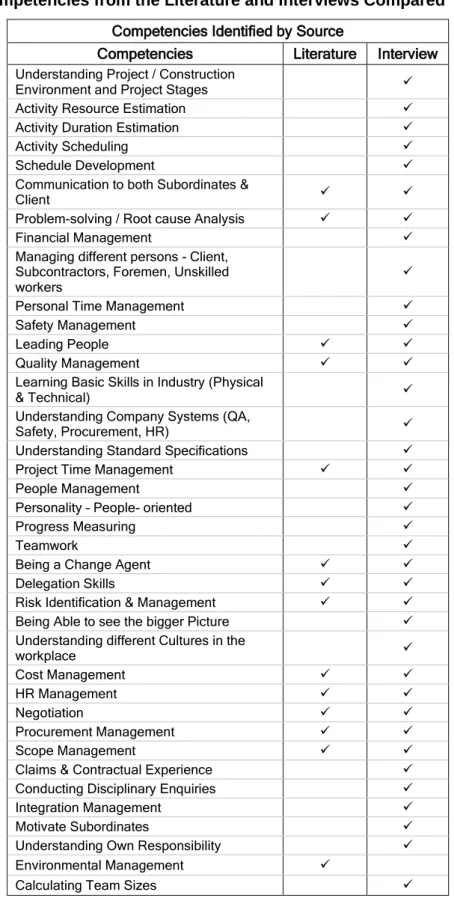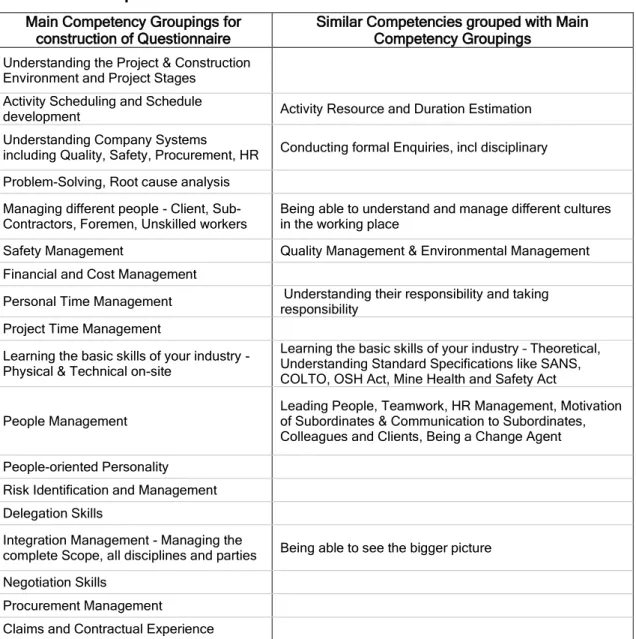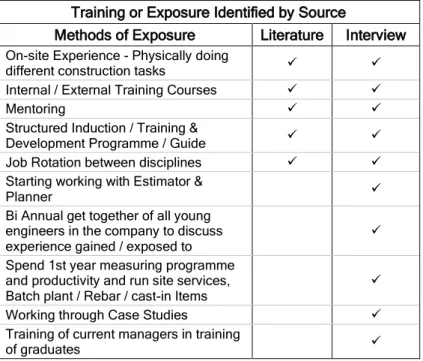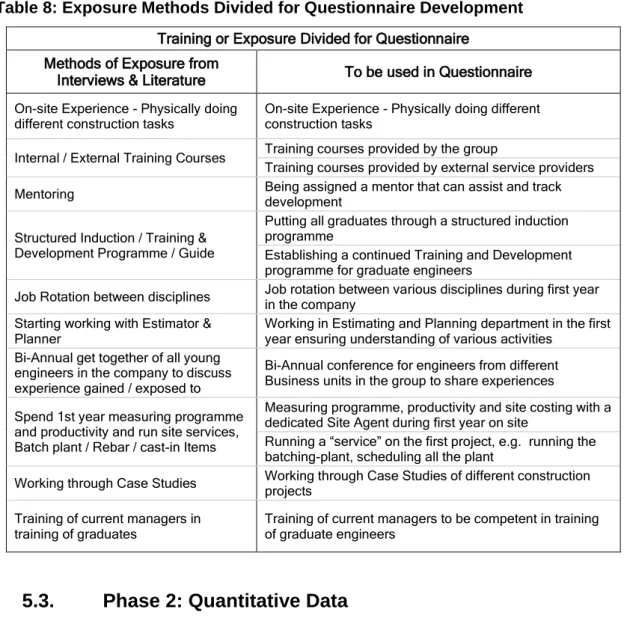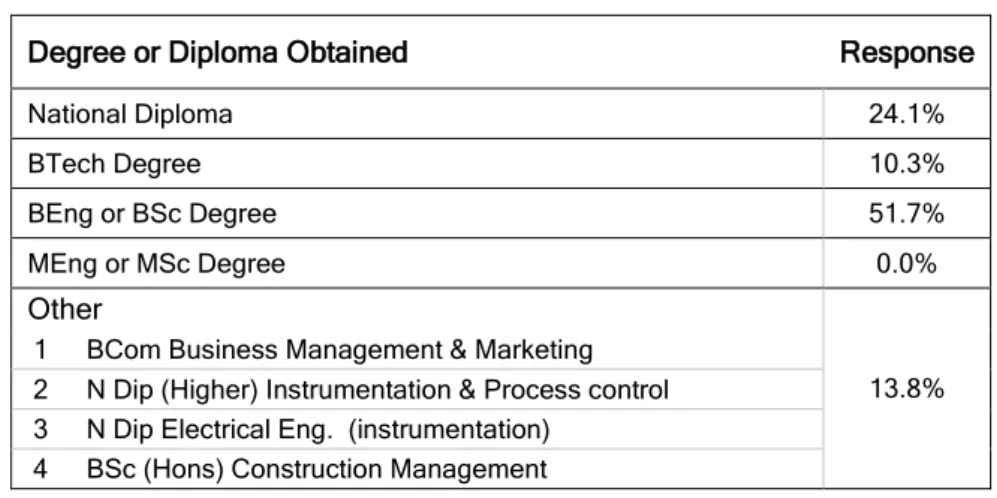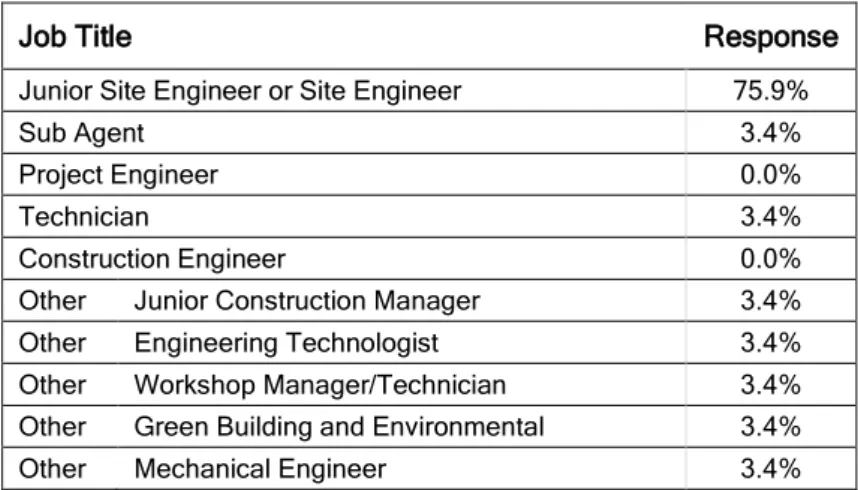The study also identified six methods that would be appropriate to develop these, but found a significant difference in the opinions of the different groups surveyed as to which methods would be most appropriate. It appears that one of the main differences between the views of graduate engineers and those of senior staff is their view of physically working on a construction site and gaining experience in this way, as opposed to receiving formal training early in their career.
Introduction to the Research Problem
- Background
- Research Problem
- Research Rationale
- Scope of the Research
- Research Objectives
- Outline of the Study
Second, which methods would be most appropriate to develop these competencies in engineering graduates in the construction industry. Determine the development needs of engineering graduates in project management, based on the views of senior managers and personnel in the construction industry.
Theory and Literature Review
Introduction
Graduate Engineers
The actual career options for graduates include working in a design office but also working for the public sector either in design or management, getting involved in education by becoming lecturers or professors, entering the engineering industry where they can go into technical sales or business development, and construction where they are likely to end up as project managers and later as part of the management team of a company (2Ci12ican, Civil Engineers). In a construction company, graduate engineers start their careers as site or field engineers and become part of the site management team.
Career Stages in Engineering and Construction
Some of their responsibilities include the health and safety aspects of the part of the job they are working on, helping to organize and supervise people and equipment on that part, dealing with potential subcontractors and setting out part of the work based on the study and interpretation of construction drawings (Career Structure, 2012).
Project Management
- What is a project?
- Project management
- Project management competencies
Another important factor in the allocation of resources is the project manager's regard for the company as a whole. Before the schedule can be developed, the project manager must understand the overall time frame for the project.
Project Management Competency Development
- Project management competency development in engineers
- Professional and career development
One of the world's leading organizations in project management is the Project Management Institute (PMI). This then requires the advancement of learning and development of project management competencies among engineers.
Project Management Competency Development Processes
- Training and learning in adults
For learning to take place effectively, it must meet the individual's needs in his or her personal environment and must be relevant to the person's work environment. Positive correlations have been demonstrated in previous studies between mentoring and its effect on salary, job satisfaction, promotion and career satisfaction for the employee or mentee.
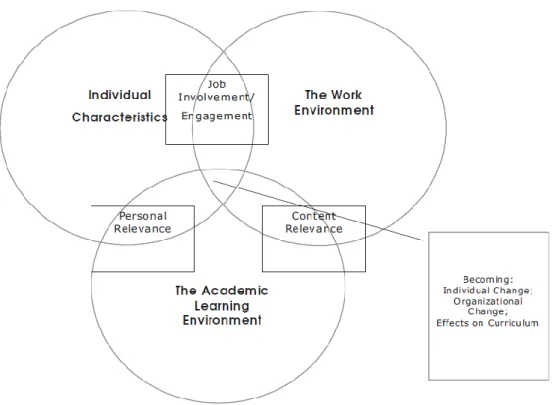
Perceptions of Management Development
Conclusion on the Literature Review
Research Questions
Research Methodology
- Introduction
- Phase One
- Research design
- Population
- Sample
- Unit of analysis
- Data collection tool
- Data collection
- Data analysis
- Phase Two
- Research design
- Population
- Sample
- Unit of analysis
- Data collection tool
- Pre-testing of the questionnaire
- Data collection
- Data analysis
- Research Limitations
The sample (Keller, 2008) for the research was civil engineers, HR professionals and senior managers from various management levels in one of the five largest construction groups in South Africa. After each of the interviews, different competencies were identified from the discussion and tabulated in a Microsoft Excel worksheet. The research design for this phase of the research was quantitative surveys (Keller, 2008; Saunders & Lewis, 2012).
Data for this phase of the research was collected by circulating electronic questionnaires to graduate engineers, human resources professionals and management at various levels in a South African construction company. The sample (Keller, 2008) for the research was civil engineers, human resources professionals and senior management (former project managers) from different management levels in one of the five largest construction groups in South Africa. The web-based program (Survey Monkey) has a function that allows the compilation of all the data from the different questionnaires to easily compare the data.
The following sections were based on the results from the interviews from Phase One of the study. With the help of the human resources department, an employee database was created consisting of all engineers and technicians who graduated up to five years. The first step of the data analysis was to combine the data from the three different surveys into one data set.

Results
Introduction
Phase One: Qualitative Data
- Graduate engineers
- Human resources professionals
- Senior managers and managing directors
- Combined responses from the interviews
- Competencies
- Development methods
- Construction of the questionnaire
The top four skills identified by graduate engineers as the most important to develop during their first five years in the construction industry were activity duration estimation, activity planning, activity resource estimation and better understanding of the project and construction environment. The competences mentioned are all relevant and were all used in the second phase of the research. HR professionals identified six methods that they believed were most relevant to gaining experience with the identified competencies (see Appendix 4).
This was a good indication that if HR professionals were involved in the development plan, their ideas would complement those of other staff members. All managers actively participated in the interviews and were very enthusiastic about the topic of developing graduate engineers in companies and the construction industry. Bi Annually all the young engineers in the company gather to discuss the experience gained/exposed.
The interviewees identified a total of 37 competencies, but only 14 of them were also recognized in the literature. This was done in Table 6 below before the list of competencies was used to construct the questionnaires for the second phase of the research. A biannual meeting of all young engineers in the company to discuss the experiences gained/exposed.
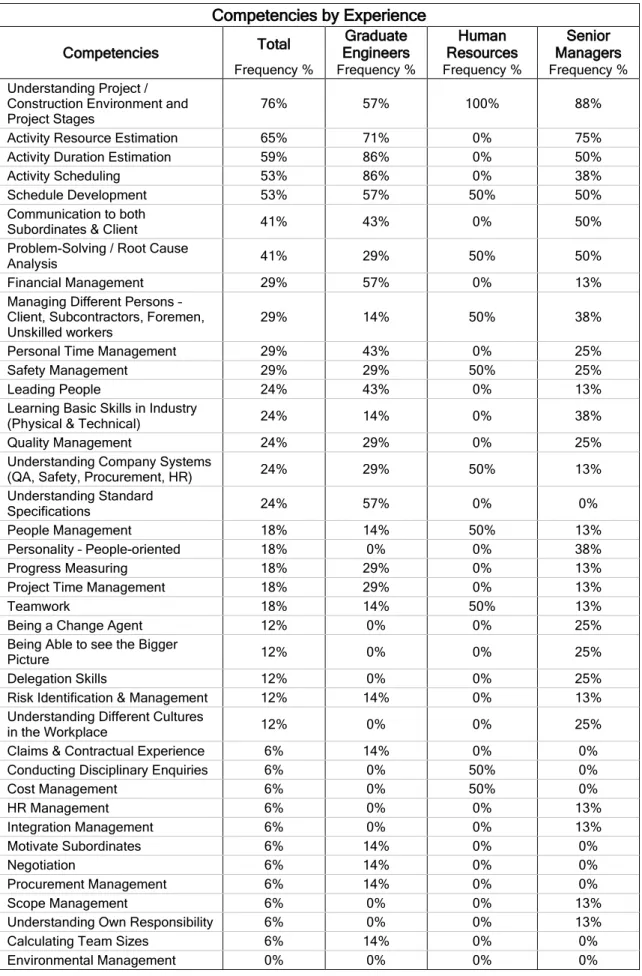
Phase 2: Quantitative Data
- Sample description for questionnaires
- Graduate engineers
- Human resources professionals
- Senior managers and managing directors
- Career development
- Project management competencies required by graduate engineers
- Methods for project management competency development
- The construction industry for the graduate engineer
We sent the questionnaires to a total of 184 recipients in the construction company with the help of the personnel department and the information technology department. Table 10 shows that the majority of responses came from engineers who had completed a BEng or BSc degree at university. This agrees well with the results in Table 9, which show that the majority of respondents qualified in 2008 or later.
The main concerns are whether this experience compares well with experience in the construction industry and how the opinions of HR professionals compare with those of respondents in the other two fields. Comparing the results from this table 17 with those in the previous table, it can be seen that although 87.5% of HR professionals had more than 10 years. The breakdown of respondents regarding their current job titles can be seen in Table 18.
This is definitely an important point, because senior managers are responsible for this development in the eyes of engineers and HR professionals. It is beneficial that they agree, as it is also the responsibility of HR professionals to develop training programs for graduate engineers. The table shows that only 7% of the entire group of respondents agree that we definitely discuss the topic with graduate engineers.
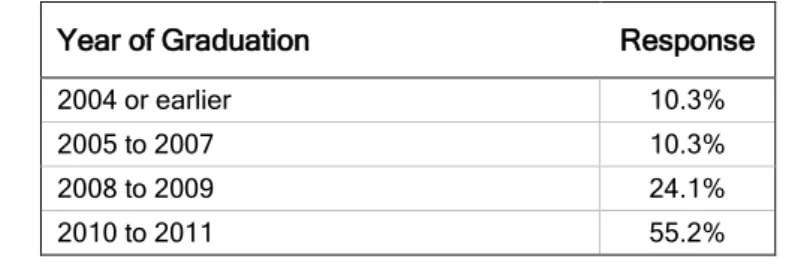
Discussion of the Results
- Introduction
- Research Question 1
- Research Question 2
- Research Question 3
- Research Question 4
- Research Question 5
- General Findings from the Study
It is clear that on average the director of contracts would take the most responsibility for the task of exposing engineers to various career options in the construction industry. However, it is important to note that project managers and HR personnel are not far behind in the ranking. It can therefore be concluded that these competencies are not crucial for the development of graduate engineers during their first two years in the construction industry.
This would prove that the findings of the study by Muchiri et al. (2011), who found that there are clear differences in perspectives between managerial (or senior) and non-managerial (or junior) employees, do not hold in relation to project management competencies in the construction industry among engineers, HR professionals and senior managers. It is very interesting that for the first two competencies in the table, it is the graduate engineers who rate these competencies as less important. The purpose of research question 4 was to identify different methods for the development of project management competences among graduate engineers in the construction industry and which methods would be considered the most appropriate or relative in terms of the construction environment.
The different methods were ranked using the sample mean of the 5-point rating scale in the data collection tool. So, there is a statistically significant difference between the opinions of graduate engineers, human resource professionals and senior managers about which methods are most important in developing project management competencies in graduate engineers in the construction industry. It is therefore clear that there are distinct differences between the methods that graduate engineers, human resource professionals and senior managers find most appropriate in developing project management competencies in graduate engineers.
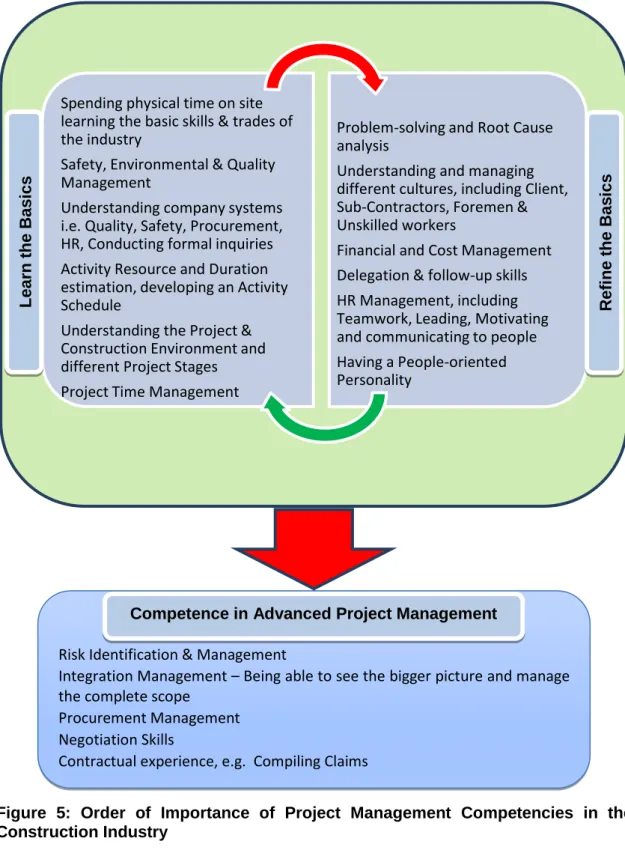
Conclusion
- Introduction
- Discussion of Findings
- Project management competencies
- Development methods
- Recommendations
- Recommendations for construction companies
- Recommendations for graduate engineers
- Recommendations for Future Research
- Concluding Remarks
This confirms claims in the literature that it is important for a graduate engineer to first learn the basics of the construction industry before undertaking more advanced project management. After identifying the project management competencies that need to be developed in graduate engineers, it was important to identify the most appropriate methods to accomplish this in the construction industry environment. Six methods were identified as most applicable to the development of project management competencies among graduate engineers in the construction industry.
All of these findings and recommendations should improve the quality of project management teams that the company ultimately needs to compete in the industry. The study was specifically aimed at developing project management competencies, but feedback from different groups of respondents indicated that there are a variety of other career options available to engineering graduates. Therefore, it is possible to conduct a more global study on the development of graduate engineers in general, rather than specifically focusing only on project management.
Therefore, the findings of this study are about which project management competencies should be developed in postgraduate studies. Development and implementation of an industry-led project management professional development program: A case study in project management and success management education. Young, Handbook of project management: A practical guide to effective policies, techniques, and processes (pp. 53–74).
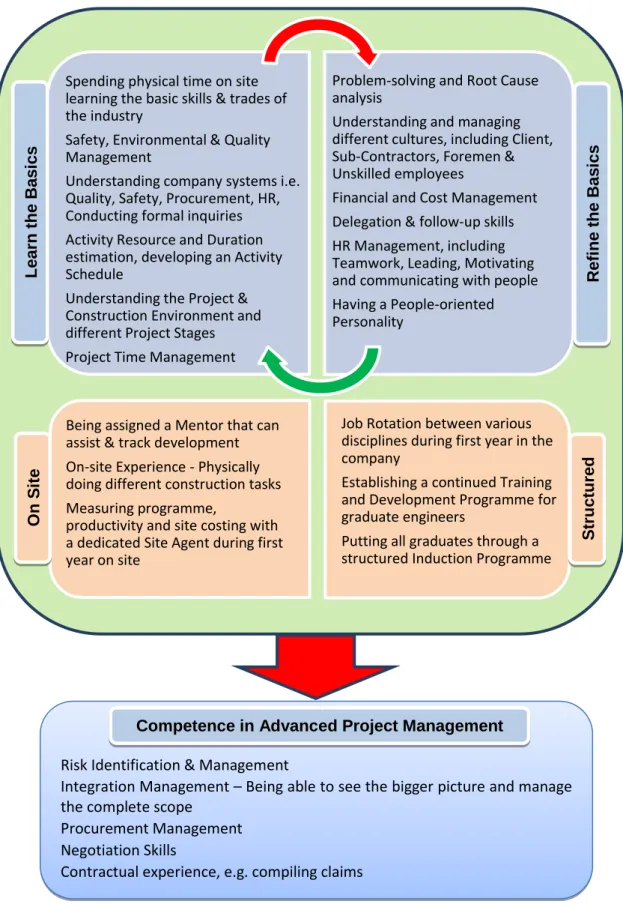
Typical Organogram of a South African Construction Company
Interview Guideline
Consent Form for Interview
Matrix for Analysis of Interviews
Survey Sent to Graduate Engineers
Project Management Competencies – IBM SPSS Data Output
The distribution of human resource management, including teamwork, leadership, motivation and communication with people, is the same across discipline categories. Management – The ability to see the bigger picture and manage the entire scope is the same across all discipline categories.
StatTools: Competency – Spending Physical Time on Site
StatTools: Competency – Safety, Quality and Environmental
StatTools: Competency – Problem-Solving and Root Cause Analysis 125
Competency Development – IBM SPSS Data output
The distribution of Training of current managers to be proficient in the training of graduate engineers is the same for the categories of V1.
StatTools: Development – On-Site Experience
StatTools: Development – Training by the Company
StatTools: Development – External Training
StatTools: Development – Job Rotation
StatTools: Development – Working in Estimating Department
StatTools: Development – Running a Service on First Project


